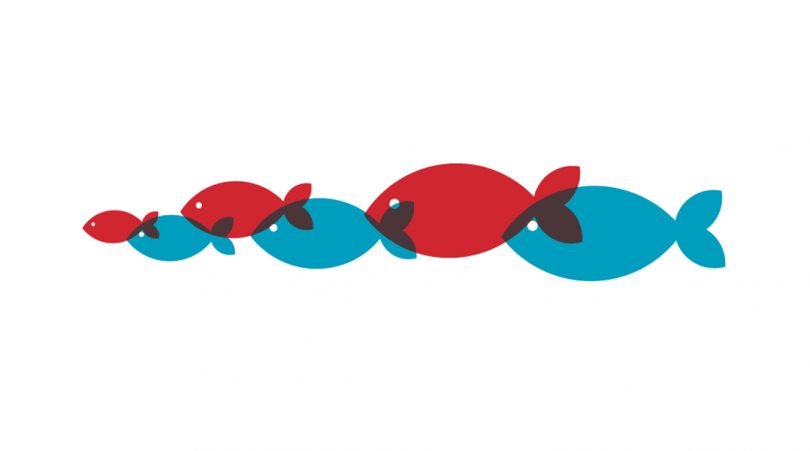Written by Susan Smigielski Acker
(Read How to Purchase Seafood at the end of this article)
Buying sustainable fish and shellfish can boost your health and keep the environment thriving, too
One fish, two fish, red fish, blue fish—
Dr. Seuss was onto something.
Omega-three fatty acids, found in certain fish, have been shown to support brain, eye
and joint health. Omega-threes may also reduce the risk of heart disease and cancer, and help modulate blood pressure and triglyceride levels. However,
before taking a bite consumers should consider a few key factors.
Safe to Eat?
Linda Candler, director of marketing at the Virginia Aquarium in Virginia Beach and former vice president of the National Fisheries in Washington, D.C., says the United States has the best food safety laws in the world.
The Food and Drug Administration (FDA) inspects not only domestic-caught fish, but also fish that come in from overseas. “Federal and state laws govern the purity,” she says.
When purchasing seafood, Steven Wilson, chief quality officer for the National Marine Services, an arm of the National Oceanic and Atmospheric Administration (NOAA), says look for the label “USDA Grade A.” That means the plant the seafood has come from has elected to be inspected by the National Marine Services.
“We are non-bias inspectors who check for net weight. These plants pay a fee for these services,” he says. “We inspect for added water, storage, odor, that the fish is not falling away from the bone, and overall freshness.”
Wilson has been on the job for 29 years. He says it takes a trained nose and palate to do the inspections.
“Odor is important not just for freshness, but the type of feed [used at a fish farm] could cause an odor. For example, if catfish has not been given good feed, it will produce a blue grass odor, which affects the taste.”
Inspecting for added water is also important.Wilson cites scallops as a species that absorbs water easily. “And if you are paying $10 a pound for scallops, you don’t want to be paying $10 a pound for water,” he says.
The inspection process includes looking for blood spots on white fish. “[White fish] is used for fish sticks, and [blood spots] will show up in the end product,” Wilson explains.
Certain fish-processing plants elect to be inspected because it makes their products more marketable to institutions such as schools, prisons and hospitals. Only 10 percent of plants choose this program, but Wilson says they make up “about 20 percent of the seafood that is out there.”
Depending on the size of the plant, it could be inspected as little as four times a year or, in some cases, Wilson says an agent can visit every day.
Sustainable Seafood
Sustainable seafood is sensible seafood, says Vicki Clark, marine education coordinator for Virginia Institute of Marine Science in Gloucester. Sustainable seafood comes from sustainable fisheries and fish farms. Sustainable means that the fisheries and farm t have healthy populations. They harvest the fish in an environmentally friendly and are able to keep up with consumer demand, according to information provided by The Virginia Aquarium.
Chandler says The Virginia Aquarium, in partnership with the Monterey Bay Aquarium in California and an advisory panel of regional seafood experts, determines which types of seafood are best to eat because of their abundance.
The list is divided into three categories: green is the best choice, yellow a good alternative and red should be avoided. In some cases the yellow and red categories only apply to fish from a certain region of the world. For a pocket guide, visit the Virginia Aquarium or the website virginiaaquarium.com.
Different species of fish mature quickly and reproduce in large numbers. However, some species, such as sharks, reproduce and mature slowly—landing them in the red zone.
Examples of fish in the green zone (best choices) are U.S. farmed catfish, clams, mussels and oysters. Wild caught fish in the green zone include rainbow trout and striped bass.
Yellow zone (good alternatives)species include wild clams, oysters and black sea bass.
“Any commercially available seafood is not endangered. There is no risk at the grocery store, Clark says.
But Chandler warns that if current unsustainable practices continue, there is a chance many types of seafood, including Atlantic Halibut and Mahi Mahi could not be available in the coming years.
Impact of Recreational Fishing
Recreational fishermen must purchase a fishing license. The license indicates which fish are protected at certain times of year. Knowing what to catch or purchase at what time of year is critical in keeping our waters healthy with fish, Clark says.
Seasons are determined by the reproductive cycle of each female species, according to Clark. For example, the blue crab cannot be caught in the winter because that is their reproductive period. “And we need more females for future years,” she notes, adding that a special license is required to catch crabs.
Mike Marsala of Virginia Beach has been fishing in Hampton Roads for 22 years. Although overall there are fewer fish, and regulations have put limits on the number and size of fish that can be caught, Marsala says this area is still very fortunate when it comes to recreational fishing. “We can catch fish 12 months of the year,” he says.
Recreational fishing comes with the risk of polychlorinated biphenyls (PCBs) in fish. The chemical contaminant may increase the risk of cancer if consumed in large amounts, according to the Virginia Department of Health.
The Virginia Department of Health lists the type of fish that are most likely to contain PCBs, and guidelines for eating them, online at vdh.virginia.gov/epidemiology.
For example, striped bass caught from the Chesapeake Bay should only be consumed about twice a month.
However, eating more than the recommended amount of fish doesn’t definitively mean a person will experience adverse health effects. The recommendations are based on laboratory animal studies and considering the worst-case scenarios, according to the Virginia Department of Health (VDH).
VDH issues warnings on certain waterways when PCB levels are high. It is determined by analysis of data from fish tissues collected by the Virginia Department of Environmental Quality, Clark says.
Shellfish
When purchasing shrimp, make sure it has been wild-caught. While some fish, such as catfish, have done well in aquacultures (fish farms), shrimp has not.
Clark says concerns over mercury exclude shellfish from the dietary recommendation to have two servings of fish a week. Instead, shellfish should be consumed less frequently.
“The FDA advises that pregnant women, young children and the elderly be cautious of shellfish because of mercury levels found,” she says.
Shellfish do not naturally contain mercury. But from the 1920s to 1970s, industrial waste was dumped into waterways, even bodies of water not near a particular industry suffered because the waste washed down into various rivers and the Chesapeake Bay, Clark says.
That contamination lingers in deep water, sparking a train reaction: Small fish feed off of plants and sediment in the water, and when shrimp and other shellfish eat the small fish, they absorb the mercury, Clark says.
Not only are industries to blame for seafood sometimes being negatively affected, so are agriculture, lawns and golf courses. “With excess nutrients and fertilizer is … the rain falls and it ends up in our waterways. In turn that fertilizer makes the plants, fido plankton, grow faster. Those plants growing too much, too fast, takes on excess nutrients and causes low oxygen. When a plant dies, the decomposition requires oxygen, taking it from the fish,” Clark says.
Changes in how industries dump waste in the past 40 years have resulted in the Chesapeake Bay being the cleanest it has been in nearly 50 years, Chandler says.
However, there are still dead zones in the bay, where there are no fish to be caught, Clark says.
Further actions can be taken to improve the health of the Chesapeake Bay, though, and local efforts are making an impact. For many years the oyster population in the Chesapeake Bay was diminishing. Candler says in the Hampton Roads community, however, oysters are coming back. Candler advises when eating oysters it is best to steam or roast them rather than eating them raw. The cooking process is most likely to rid the oysters of bacteria.
FYI: Virginia is best known for blue crabs, scallops, clams, croaker, spot, striped bass and oysters. Download a pocket guide of sustainable seafood at Virginiaaquarium.com
————————-
How to Purchase Seafood
Wondering if the seafood being purchased is fresh? Culinary Institute of Virginia Instructor Chef Stephen Perkins says “the nose knows.”
“Smell it. If it smells fishy then you may be dealing with something that you don’t want to eat and could possibly make you sick,” he says.
“You do not want to buy anything that has been sitting around too long,” Perkins adds.
It is best to buy fresh fish that has not been fillet if possible. “It is not very attractive to look at, but if you can buy a whole fish look at its eyes. If they are bulgy, that is good. If the gills are bright, that is also good,” he says.
However, if buy already filleted fish from behind the counter ask the salesperson to press (with a gloved hand) on the flesh, it should bounce back. If an intention is left, it is not fresh.
For shellfish, an ammonia smell means it is not fresh even if it was previously frozen. “That just means it frozen like that, not fresh,” he says.
Shellfish such as clams, oysters and mussels should be purchased with the shells closed.
If consuming fresh seafood on a regular basis, Perkins says it is good to develop a relationship with a person working the counter at a local grocery store or fish market.
“If you have a relationship with someone at a fish market or grocery store, they will look out for you,” he says.
When cooking fish, Perkins says it is important to cook thoroughly. “For white fish, to tell if it is done, it should be flaky, nothing raw. This is important because if not cooked all the way, there could be some parasites in it that would not have been killed,” Perkins says.
Clams, oysters and mussels are done when the shells pop open. Perkins says they should have a fresh, saltwater taste if they are fresh.
Do not attempt to make sushi at home. “Sushi chefs have special training. It is best to purchase it from a place where they know what they are doing,” he says.
Buying From A Small Vendor
Ever wonder if the seafood being sold from the back of a truck is safe? Clark says it most likely is fine because every fisherman selling from a truck is required by law to tag the portions.“Ask to see the tag. It should say on the bag when it was caught, where it was caught and who caught it,” Clark says.
The same goes for a fish market. They are required to only sell fish that is legal to be caught at that time, Clark adds.


